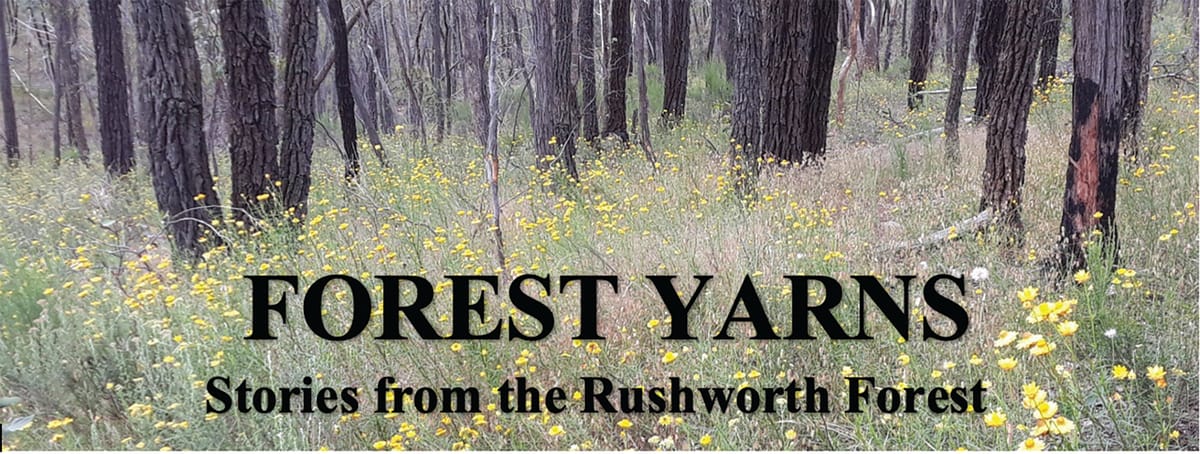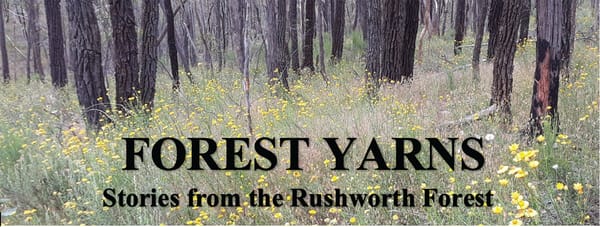Later wood mills at the station

In the early part of the 20th century, there were typically about half a dozen wood mills at the Rushworth station, with others at stations along the Murchison to Colbinabbin railway line.
These mills “were driven by steam portable engines of around seven to eight horsepower capacity. In two of these mills, these were coupled to an ordinary push bench which needed a “benchman” and a “lumper” for their operation. In the remaining four mills, “patent” benches were used which eliminated the need for a “benchman” through the use of automatic clutches and couplings.
All benches were coupled to the engine with a 150 mm (6 inch) flat belt of leather, or composition fabric. Saw blades were generally of 1.07 m (42 inches) diameter of 9-gauge steel.”1
Buildings
The buildings erected to protect the equipment were pretty basic. They were “simple structures and consisted of a timber frame sheeted with corrugated galvanised iron and roof and on the sides of the engine area.” 1
There was not much protection from the prevailing weather conditions and the work was hard. It is hardly surprising that the men who worked in the timber industry were physically tough. Many of them went on to form the basis of the great Rushworth footy teams of the 1930s, which won five premierships in a major league – the golden era of the Rushworth Football Club.
Spare a thought for those who took the billets off the vehicles that had conveyed them to the station, stacking them vertically as close as possible to the mill. Also, those who loaded the empty rail wagons, known as “stackers”. They “took sawn blocks and stacked them directly into the rail wagons beside each mill.”
Sites of the mills
Post World War 1, two mills were located “adjacent to the line servicing the (existing) goods shed. The mill at the eastern end next to the platform had only one owner in Jack Perry and Sons…It was one of the last mills to set up.”
“The second mill was located on a spur off the goods shed line at the western end, and adjacent to the livestock trucking yards. It was operated by various proprietors such as Anderson and Colliver and later Jim Poulson. This was the last mill in operation.
“The other mills were located on the branch line running to the north of the goods shed” and included the mill “close to the junction with the branch line of the goods shed.” This mill was owned by Bill Curtis and his family. The next mill to the west was started by Mick Wall and sons and later owners included George Risstrom and Sons. Still further west was the mill operated by Mr Curtis Snr and son Walter. This mill was later operated by George Risstrom and sons and Peter Kenny. The last of these mills was just west of the access road to the goods shed, with the owners including Jones Bros and Leo Armstead.”1
Seasonal nature
Getting billets of wood out of the forest was seasonal. Roads and tracks were often impassable during the winter months, especially with the potential for traction engines to churn them up. Consequently, the mills used to stockpile billets before winter to ensure they had enough to be able to provide a steady supply of firewood. When it was time for the billets to be moved from the stockpile to the mill, a low horsedrawn trolley was used.
Horse drawn vehicles carting timber used to come in from the Whroo Road along High Street then turn down Wigg Street to avoid the centre of town. They would use the former bridge across the railway tracks that linked Murchison Road to Moora Road before Station Street was constructed. Traction engines would avoid High Street because of the potential to upset horses and damage the road surface.
The former reason was also behind the famous Rushworth whistle post signs, two of which used to be on the Whroo Road. On hearing the whistle, horse owners had time to secure their animals as the traction engines entered the town precinct.
Reference: Spiby, Tracey, notes on historic “Firewood Milling Operations” at Rushworth , per favour Ted Jones.
Forest nature note
You might have noticed quite a few under-storey plants that are dead or dying in the forest now. These are plants that prospered over the last few years with the wetter conditions but cannot sustain themselves in this year’s extended dry period. One of the local species that seems to fare the worst is Acacia paradoxa, which has a variety of common names – Kangaroo Thorn, Kangaroo Acacia, Prickly or Hedge Wattle. This is despite the plant being regarded as drought and frost tolerant.




